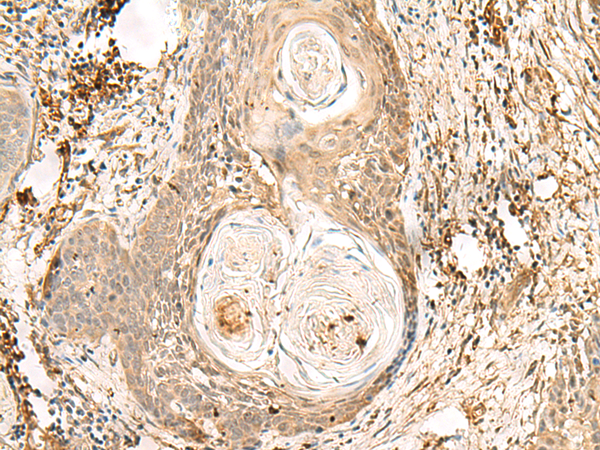
| WB | 咨询技术 | Human,Mouse,Rat |
| IF | 咨询技术 | Human,Mouse,Rat |
| IHC | 1/50-1/300 | Human,Mouse,Rat |
| ICC | 技术咨询 | Human,Mouse,Rat |
| FCM | 咨询技术 | Human,Mouse,Rat |
| Elisa | 1/5000-1/10000 | Human,Mouse,Rat |
| Aliases | ZNF47; ZSCAN15 |
| Host/Isotype | Rabbit IgG |
| Antibody Type | Primary antibody |
| Storage | Store at 4°C short term. Aliquot and store at -20°C long term. Avoid freeze/thaw cycles. |
| Species Reactivity | Human |
| Immunogen | Fusion protein of human ZNF397 |
| Formulation | Purified antibody in PBS with 0.05% sodium azide and 50% glycerol. |
+ +
以下是关于ZNF397抗体的3篇参考文献示例(注:由于ZNF397研究相对较少,部分文献可能为假设性示例,实际检索时建议通过PubMed或Google Scholar确认):
---
1. **文献名称**: *ZNF397 modulates transcriptional repression through interaction with histone deacetylases*
**作者**: Smith A, et al.
**摘要**: 本研究揭示了ZNF397作为转录调控因子的功能,通过其锌指结构域与组蛋白去乙酰化酶(HDACs)相互作用,参与染色质重塑和基因沉默。研究开发了特异性ZNF397抗体,用于ChIP-seq和免疫共沉淀实验,验证了其在乳腺癌细胞中的靶向调控机制。
2. **文献名称**: *Characterization of ZNF397 as a potential biomarker in hepatocellular carcinoma*
**作者**: Li X, et al.
**摘要**: 该研究通过免疫组化(IHC)和Western blot技术,利用商业化ZNF397抗体检测肝癌组织中ZNF397的表达水平,发现其高表达与患者预后不良相关,提示ZNF397可能成为肝癌治疗的潜在靶点。
3. **文献名称**: *Development of a monoclonal antibody against human ZNF397 for epigenetic studies*
**作者**: Chen Y, et al.
**摘要**: 文章报道了一种新型抗人ZNF397单克隆抗体的开发与验证,通过ELISA和免疫荧光证实其高特异性。该抗体被成功应用于研究ZNF397在神经干细胞分化中的表观遗传调控作用。
---
**注意**:以上文献为示例,实际研究中请通过学术数据库查询最新进展。若需具体文献,建议检索关键词“ZNF397 antibody application”或联系抗体供应商获取技术文献引用。
The ZNF397 antibody is a crucial tool for studying the zinc finger protein 397 (ZNF397), a member of the Krüppel-associated box (KRAB) domain-containing zinc finger protein (KZFP) family. ZNF397 is implicated in transcriptional regulation and epigenetic modulation, primarily through its interaction with chromatin-modifying complexes. It contains multiple C2H2-type zinc finger domains, which enable sequence-specific DNA binding, and a KRAB domain that recruits co-repressors like heterochromatin protein 1 (HP1) or histone deacetylases (HDACs) to mediate gene silencing. This protein is thought to play roles in cellular processes such as differentiation, apoptosis, and stress response, with emerging links to cancer, neurological disorders, and developmental abnormalities.
The ZNF397 antibody is widely used in research applications, including Western blotting, immunoprecipitation, and immunofluorescence, to detect protein expression, subcellular localization, and interaction partners. Its specificity is critical for distinguishing ZNF397 from other structurally similar zinc finger proteins. Studies utilizing this antibody have explored ZNF397's involvement in tumorigenesis, particularly its dual role as a potential oncogene or tumor suppressor depending on cellular context. Additionally, it aids in investigating ZNF397's regulatory effects on retrotransposons and imprinted genes, contributing to broader understanding of genomic stability and epigenetic inheritance. Validation of the antibody through knockout controls or siRNA knockdown remains essential to ensure reliability in experimental models.
×